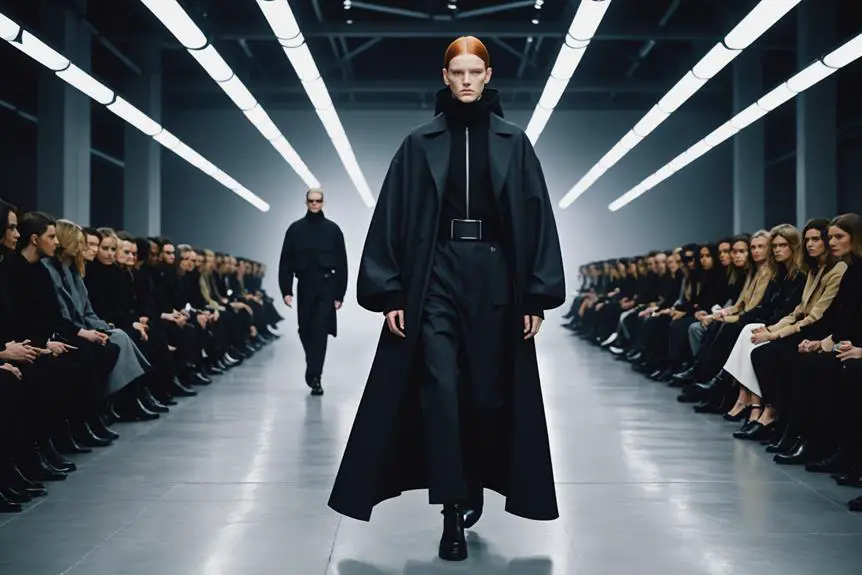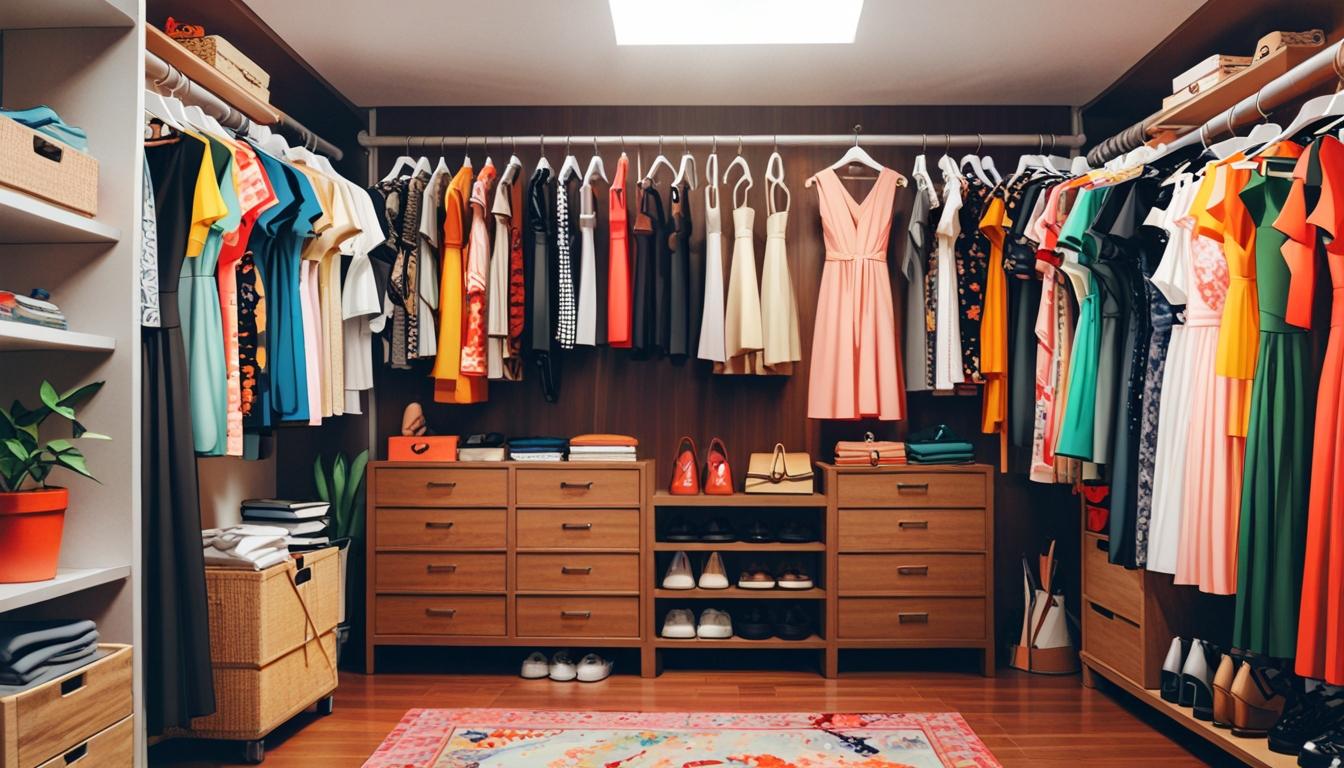In the 1940s, women's dresses showcased a unique fusion of wartime practicality and post-war optimism. You'd see iconic styles like the fitted shirtwaist, playful puff sleeves, and streamlined pencil dresses, all celebrating feminine curves. Fabric choices were innovative yet limited, often using spun rayon and sturdy cotton blends. Colors evolved from muted shades of navy and army green to vibrant tones like emerald and mustard, reflecting a shift in society. Designers like Christian Dior redefined silhouettes, while Claire McCardell focused on functionality. Explore further to uncover the rich details of how accessories completed these stunning vintage looks.
Overview of 1940s Fashion

Fashion in the 1940s, shaped by both wartime necessity and post-war renewal, presents a fascinating blend of femininity and practicality. You'll notice that this era emphasizes an hourglass silhouette, combining feminine curves with masculine design elements, influenced by icons like Bette Davis and Ingrid Bergman. The dresses of this time often feature nipped waists and statement collars, showcasing a commitment to high-quality, hand-made garments that prioritize durability. Many vintage dresses from this period are characterized by unique labels indicative of their craftsmanship and era, which can enhance their value among collectors. During World War II, fabric shortages led to the rise of utility clothing, which encouraged innovative designs. Tailored suits and military-inspired styles became popular among women, allowing for both versatility and style. As the war ended, Christian Dior's "New Look" emerged, shifting the focus back to femininity with fitted bodices and fuller skirts, contrasting sharply with the practical styles of the previous years.
Floral patterns and vibrant colors—like red, green, and navy—defined the dresses of the 1940s, reflecting the era's challenges and hopes. With practical elements like low-heeled shoes, these vintage dresses encapsulated the resilience and optimism of women maneuvering a rapidly changing world. Understanding the historical context of brands and their unique identifiers can greatly enhance appreciation for these garments, as seen in vintage clothing labels.
Iconic Dress Styles
Throughout the 1940s, several iconic dress styles emerged that defined women's fashion during this transformative decade. The shirtwaist dress became a staple, featuring fitted bodices and flared skirts that highlighted the hourglass silhouette. It was practical yet stylish, making it a favorite among women of all ages.
Puff sleeve dresses also gained popularity, characterized by wide shoulders that accentuated femininity while maintaining comfort. These dresses often incorporated playful designs, like polka dots, which added a touch of whimsy to everyday wear.
As the decade progressed, the pencil dress made its debut, showcasing a tailored silhouette with a narrow waist and fitted pencil skirt. This style represented a shift towards a more sophisticated, modern aesthetic.
The following table summarizes these iconic styles:
| Dress Style | Key Features |
|---|---|
| Shirtwaist Dress | Fitted bodice, flared skirt |
| Puff Sleeve | Wide shoulders, feminine fit |
| Pencil Dress | Tailored silhouette, body-hugging |
| A-line Dress | Casual comfort, vintage aesthetic |
| Patterns | Floral designs, polka dots, muted colors |
These styles collectively reflect the resilience and adaptability of women's fashion during the 1940s, setting the stage for future trends.
Fabric and Construction Choices

In the 1940s, many dresses were crafted from innovative and durable materials, reflecting both the era's challenges and its creativity. The fabric choices were influenced largely by wartime shortages, leading designers to explore alternatives that maintained style without sacrificing quality. Vintage clothing labels from this period often indicated the materials used and the craftsmanship involved, providing insights into the garment's history and value. You'd often find vintage dresses made from a combination of:
- Spun rayon, offering a soft, luxurious feel
- Twill cotton blends, typically 65% cotton, 30% polyester, and 5% spandex, ensuring comfort and flexibility
- Unique lace accents, adding a touch of femininity
- Pleats and ruffles, enhancing the dress's silhouette
- Sturdy stitching, ensuring quality construction for lasting wear
The emphasis on custom-made pieces meant that these dresses were not just stylish; they were built to withstand everyday life. Each garment often came with care instructions, underscoring the importance of maintaining these high-quality fabrics. Detailed insights on vintage tags can enhance understanding of the era's fashion. The meticulous construction and thoughtful fabric choices of the 1940s resulted in dresses that celebrated both functionality and aesthetics, reflecting a time when every piece was crafted with purpose and precision.
Color and Pattern Trends
The 1940s color palette showcases a fascinating evolution shaped by wartime realities and post-war optimism. During the early part of the decade, muted tones dominated, with shades like navy blue and army green reflecting fabric production restrictions. Red, white, and blue were prevalent, symbolizing patriotism amid the turbulent times. As the war drew to a close, brighter colors began to emerge, bringing a sense of hope and renewal. You'd find lively shades like emerald green, mustard yellow, and light blue in summer collections, inviting a cheerful vibrancy.
Floral patterns gained significant popularity, often featuring small, delicate motifs that added a feminine touch to dresses. These patterns contrasted sharply with the more practical designs of the wartime period. Polka dots, checks, and stripes also flourished, offering stylish yet versatile options that women could wear daily. The bold prints reflected an optimistic sentiment as society shifted into peacetime, signaling a change from the subdued colors of conflict. The 1940s ultimately defined a period of transformation in fashion, where color and pattern trends mirrored the collective desire for joy and liberation.
Influential Designers and Brands
Emerging from the constraints of wartime fabric rationing, influential designers and brands in the 1940s played a pivotal role in reshaping women's fashion. They combined practicality with a renewed sense of femininity, leading to the rise of styles that remain iconic.
- Christian Dior's "New Look" revolutionized the silhouette, featuring a cinched waist and full skirt.
- Claire McCardell introduced vintage-inspired day dresses, focusing on functional designs for working women.
- British designers crafted utility clothing, striking a balance between style and material conservation.
- French fashion houses, like Pierre Balmain and Jacques Fath, adapted to wartime restrictions, yet maintained sophisticated elegance.
- The post-war revival of haute couture positioned Paris once again as the epicenter of luxury fashion.
These designers used innovative sleeve designs and styles that transformed the typical party dress into a hallmark piece. Their creations not only reflected the era's societal shifts but also redefined women's roles and aspirations in fashion. The legacy of the 1940s is a reflection of how resilience and creativity can lead to profound change, establishing a foundation for future trends.
Accessories and Styling Tips
Accessories played an essential role in completing the look of women's dresses in the 1940s, enhancing both style and functionality. When wearing a Blue Floral dress with a bow, consider adding a pair of mid-arm length gloves to elevate the sophistication of your outfit. These gloves not only accentuate your arms but also contribute to the vintage aesthetic that defines the era.
For a more glamorous touch, a Velvet Dress can be beautifully complemented with a few key accessories. Opt for backseam stockings that create a polished leg look, paired with wedge heels for comfort and style. Minimal jewelry, such as a rhinestone brooch or a simple pearl necklace, can add just the right amount of sparkle without overwhelming your ensemble.
Frequently Asked Questions
What Was the Dress Style in 1940?
In 1940, you'd find dresses featuring an hourglass silhouette, nipped waists, and flared skirts. Fabrics emphasized durability, while floral patterns and bold prints added flair, reflecting both femininity and practicality during challenging times.
What to Wear for a 1940S Party?
For a 1940s party, you'll want to wear dresses with fitted waists and flared skirts. Think floral patterns or bold prints, and don't forget vintage accessories like stockings and elegant hats to complete your look.
What Were the Colors of Fashion in the 1940s?
In the 1940s, fashion colors reflected the era's mood. You'd notice muted tones like army green and navy, shifting to brighter shades post-war, symbolizing optimism with vibrant floral patterns and lively hues emerging.
How Much Did a Dress Cost in 1940?
In 1940, a dress typically cost between $10 to $20, reflecting economic conditions. Utility dresses were more affordable, ranging from $5 to $10, due to wartime regulations limiting fabric and resources for clothing production.



